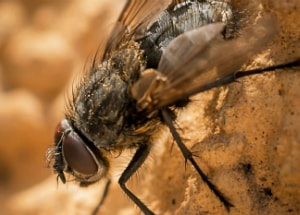Hi! Welcome to my blog dedicated to pest control and the best remedies. In this article, I tell how to get rid of flies outside and share my detailed reviews of the five most effective backyard fly control remedies. Read it attentively, and you will quickly understand how to deal with your problem successfully.
My guide also includes brief answers to the most frequently asked questions of my clients and readers, so I bet you won’t find a more comprehensive piece on the topic.
Before you start reading further, you should understand that the problem is really serious. Flies are not just annoying insects. They’re dangerous nuisance creatures which transmit severe diseases, such as cholera, conjunctivitis, dysentery, gastroenteritis, salmonellosis, tuberculosis, typhoid fever, an around 60 others. If you notice lots of flies in the backyard, it’s high time to start fighting the infestation.
[wpsm_titlebox title=”How to Get Rid of Flies Outside” style=”main”]
- Determine where flies come from, what attracts them, and where they nest.
- Isolate pets and children. Consider means and measures to protect yourself.
- Remove the fly breeding ground.
- Use insecticides and bait sprays.
- Get an electric killer.
- Set lethal baits in the yard.
- Keep your yard clean.
[/wpsm_titlebox]
Identification of Flies

Before starting to fight the infestation, you have to learn some essentials about these nasty insects to be able to identify them properly. First of all, they are medium-size insects with only two wings (most insects have 2 pairs of wings).
Adult outdoor-breeding species are usually around 0.25’’ long and have four dark-grey lines on their backs right after small heads with relatively large bright-brown eyes.
Finally, they have only 3 pairs of legs. Other common species, such as blow and bottle flies, have green, bronze, back, or even blue spots on their backs.
Flies Lifecycle
Flies are one of the most rapidly-breeding insect species. Their lifecycles are rather short, too, though. They usually breed in unstable sites, such as garbage piles and dead animal body carcasses, so they develop into adult species very fast.
Average house flies need just 6 days to complete development, while a single female fly can lay up to 900 eggs during its short life. Blow, and bottle flies usually need up to 10 days to develop, while their life span can reach two months. Fortunately, they can’t survive more than 3 days without a source of food.

Common Species and Why They Appear
Besides home (Musca domestica), green bottle, and crane flies, there are several other types that can potentially infest your yard. If there are animal hosts, such as horses and cattle around your area, you may notice an Autumn fly. It’s almost identical to a housefly.
Domestic animals presence can also cause a horse fly infestation. This large insect can reach 25mm length and bites painfully.
A cluster fly (pollinia) can infest quiet places of your house, such as attics, as it needs a calm and warm place for winter hibernation. Unlike the majority of other species, they are totally safe and don’t bite people and pets. Your attic can also become a wintering place for the yellow swarming fly, which is very similar to a fruit fly.
Fruit flies can appear not only around your kitchen rubbish bin but also on fallen fruit and berries in your garden. In most cases, it’s enough just to remove those fruit to stop the infestation as these insects can’t survive without feeding.
What Causes Fly Infestation Outside?
Bottle, blow, and domestic flies are usually attracted by rotting garbage, carcasses of dead animals, and, of course, fresh human food that looks like an easy and tasty catch for them. Your yard can get infested even if there’s a small piece of meat left after a BBQ party.
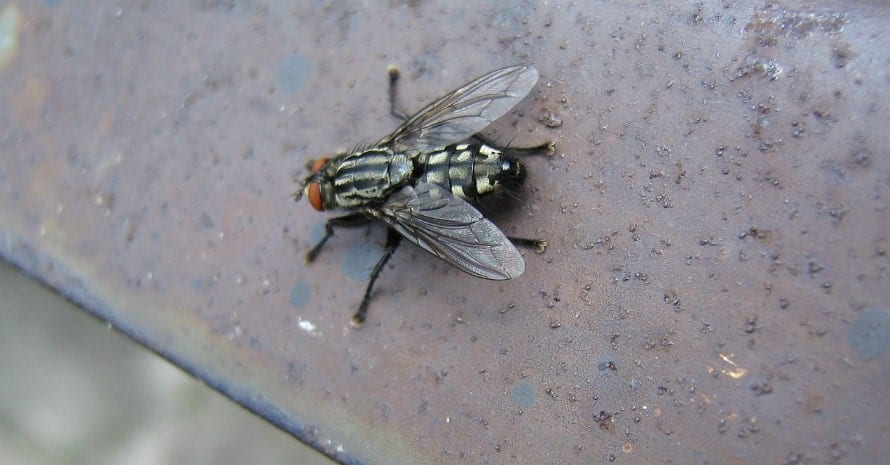
Besides, an outdoor fly is attracted by dead mice, feces of domestic and wild animals, rotting vegetation, etc. Pests can also come from an adjacent territory where horses, cattle, or pigs are kept in barns. In such a case, you should be looking for ways to repel insects continuously.
Getting Rid of Flies Outdoors: Step-by-Step Guide
Getting rid of flies in the yard is not that easy job as you have to find out the reason of the infestation first and then decide how to act. But I have prepared the instruction with effective remedies to help you with this task.
Step 1: Prepare Your Yard

If you want to get rid of outdoor flies faster, you should prepare your yard first. This step includes several stages.
First of all, you have to determine where do flies come from, what attracts them, and where do they nest around your area. I recommend you pay more attention to places where most insects spend their day. In most cases, the reason is somewhere near that location. You should look for food leftovers, dead rodents, birds, etc., rotting vegetables and fruit, pet or wild animal feces, and garbage.
The chances are high that the breeding site is hidden under or within a structure, so I recommend you to take a torch and inspect drainages, cracks in walls and outdoor floor brickwork, BBQs (and other outdoor food-related objects), the ground under fruit trees and other productive plants, etc. The mission is simple. Inspect the most active location, and you will definitely find the answer.
When this stage is done, you have to make your yard safe and convenient for forthcoming treatment. For this, you should isolate domestic animals and kids if you are using a remedy that may potentially harm them. Finally, think of self-protection items and measures, such as glasses, respirators, rubber gloves, etc.
Now you should carefully remove the fly magnet that causes the infestation. In some cases, it is also the last stage of the treatment as insects may decide that there’s nothing to eat or nowhere to breed anymore. If it’s not the case, keep reading.
Step 2: Treat Flies With Outside Fly Deterrents
Now, let’s decide on a treatment method. If there is a breeding site in your yard and you have removed it already, I recommend you use an insecticide, such as [amazon link=”B00061MSS0″ title=”Martin’s Permethrin 10%” /], that will prevent pests from returning to the location in the near future.
Next, you can treat surfaces of manmade structures around with a bait spray to eliminate the insects that don’t want to fly away. This way, you will get rid of them faster than they die of hunger naturally and prevent them from searching for a new breeding site around.
If the infestation isn’t located around your yard, but pests keep coming when you cook something or just sunbathing in your garden, you should consider purchasing a stationary electric killer like [amazon link=”B00004R9VV” title=”Flowtron BK-80D” /]. Such a device will attract and kill pests without any effort from you. Just plug it in and relax.
If there are no outlets around, you can take an electric zapper along. This device works similarly to a stationary killer but has a mobile design and rechargeable batteries so that you can charge it up with a power bank and reuse. The only minus of this solution is that you have to switch it on and manage to hit a fly with the mesh to achieve the effect. It’s not a device that will work 24/7 without your control.
The last, but not the lest way to eliminate flies is to place deadly baits around the yard or campsite. For example, a single [amazon link=”B01DL410JQ” title=”Victor M380 Fly Magnet” /] will help you to kill hundreds of flies without the need to chase them. Just place it in the center of the infested area, and you will breathe out in relief quite soon.
Effectiveness of Insecticides
Although permethrin is considered to be one of the most effective remedies on the market, scientists have noticed that flies can develop resistance to insecticides. That’s why they recommend to alternate active ingredients to fight large and reoccurring infestations.
However, I always start the insecticide treatment with permethrin and then add other components if it doesn’t provide the needed result. Fortunately, this rarely happens.
If your permethrin treatment seems to be lacking efficiency, try to apply solutions that include deltamethrin, beta-cypermethrin, propoxur, dinotefuran, or dichlorvos. These are widely used chemical components that are approved by the United States Environmental Protection Agency (EPA) and considered to be effective against a variety of nuisance pests, including flies.
The effectiveness of each component is relatively high, but the result may depend on the concentration of the chemical in the remedy composition and on the resistance of particular fly species and generations.
In most cases, the effect will be almost the same. You should also learn permissions and cautions for each product before applying it in your area to avoid harming animals and plants.
Instead, you can use natural ways to get rid of flies outside, but they’re usually less effective and require more effort from you. I recommend you to use natural remedies only while you’re waiting for your Amazon parcel to be delivered.
Repelling Flies Outside in Future
Now that you know how to kill flies outside, you should also learn to repel them to avoid reinfestation. I recommend you to keep using fly traps and zappers (when you’re on vacation) as they are always effective. Next, you have to train yourself to clean garbage sites and remove animal feces from around the yard regularly enough.
If flies like to visit your yard in the evening, you can also surround it with yellow and blue lightbulbs as they can partially keep insects behind the fence. But you should place them correctly because flies hate yellow, but they love blue.
Place them away from your house to relocate pests. Finally, you can lit citronella candles upwind to repel them with the smell when you’re resting outside.
FAQ
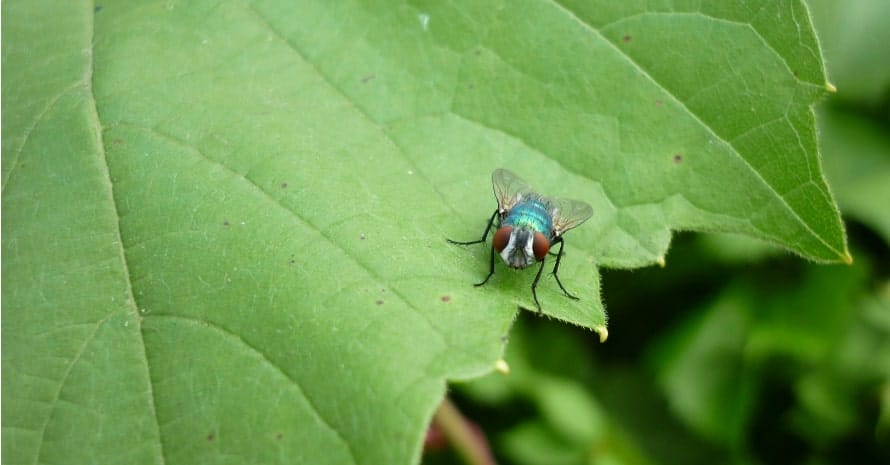
Here you can read the promised answers to the most frequently asked questions about flies around your house and getting rid of them.
Why are there so many flies outside my house?
There answer is simple. Something attracts them with a ‘tasty’ smell. It can be:
- Garbage;
- Food leftovers;
- Rotting fruit or vegetation;
- Animal carcasses;
- Feces of domestic and wild animals;
- Fresh food smell;
- All similar things.
How do I get rid of flies outside with vinegar?
It’s a natural method to trap Muscas. Here’s a simple instruction:
- Take a tall glass or a jar;
- Fill it with apple cider vinegar to the half;
- Add a few drops of dish soap and mix to get some foam on the top;
- Cover the glass with a piece of plastic wrap and fix it with a rubber band;
- Take a pencil and poke holes so that a big fly could get in;
- Congratulations! Insects will be attracted by the smell, but they won’t be able to escape foam.
What smell will keep flies away?
The most effective smell against these pesky insects is cinnamon. Use an air freshener with this scent. Besides, you can spray essential oils of lemongrass, lavender, peppermint, and eucalyptus. It’s also a good solution to grow some of these in your garden.
Where do flies lay eggs?
One fly can lay up to 900 eggs in any place that is warm, moist, and secure enough for larvae. Eggs can be found in feces, garbage, rotting vegetables, ground with organic needed materials, sewage systems, etc.
How to stop flies landing on you?
This one can be difficult as these pests love the smells of our breath and sweat a lot. You can use body scents that include repelling essential oils of cinnamon. If you are not on the go, use citronella and camphor smoke, a fan, an automatic zapper, or spray essential oils.
How to get rid of flies on the patio?
The methods are all the same. Be consistent and use the methods from above with the remedies from below and you will succeed. Always remove food leftovers from your patio and use repellents while cooking.
Top 5 Outside Fly Control Remedies: Expert Selection
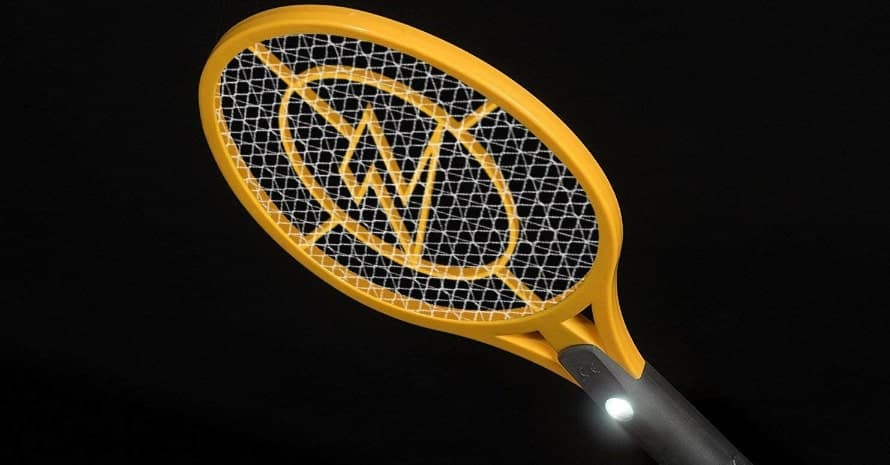
Here are the most effective products that you can buy online to start fighting the infestation as soon as possible. I’ve tested each of them multiple times in different conditions, so their relevance is approved.
1. Electronic Flying Insect Killer – Electronic Insect Killer
[amazon box=”B00004R9VV” template=”vertical” tracking_id=”how-to-get-rid-of-flies-outside-20″ button_text=”Check price on Amazon”]
Specifications:
- Luring Range: 1 Acre
- Total Power: 80 Watts
- Item Weight: 8 Pounds
- Item Dimensions LxWxH: 11 x 11 x 18.5 inches
- Target Species: All Flying Insects
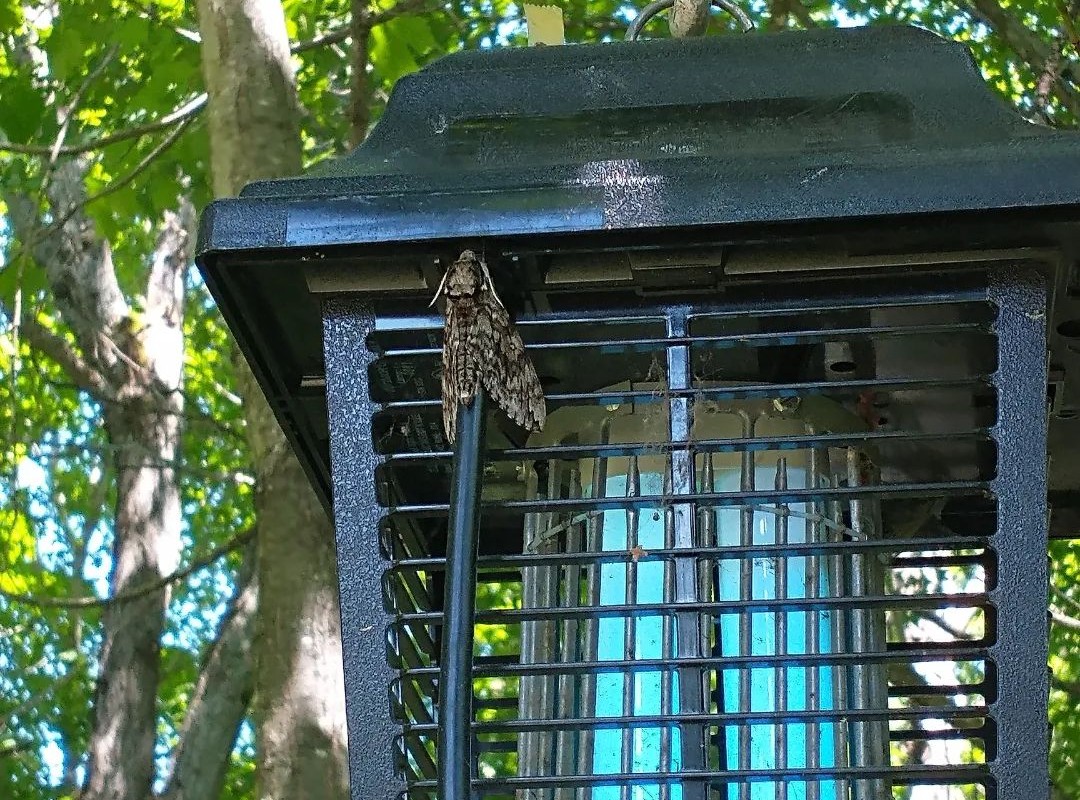
BK-80D is a powerful outdoor fly killer that’s designed to provide 24/7 protection of up to 1-½ acres of land around. You can plug it into an outdoor outlet and keep it on with very low monthly electricity consumption.
The blue lamp inside the cage attracts insects, while the electrified inner cage kills them with a discharge.
The device is totally safe for the household and protected from downfalling rain. However, I’d recommend you to remove it when it’s raining.
This item is an excellent fly repellent for patio and terrace. It will help you to get rid of flies left after you eliminate the breeding site and in those cases when the only way is to kill insects that come from adjacent territories.
| Pros: | Cons: |
|
|
2. Fly Reusable Trap – Victor M380 Fly Magnet
[amazon box=”B01DL410JQ” template=”vertical” tracking_id=”how-to-get-rid-of-flies-outside-20″ button_text=”Check price on Amazon” button_detail=”https://shareasale.com/r.cfm?b=410159&u=2583381&m=43235&urllink=www%2Edomyown%2Ecom%2Fvictor%2Dfly%2Dmagnet%2Dm380%2Dp%2D22281%2Ehtml&afftrack=how%20to%20get%20rid%20of%20flies%20outside” button_detail_text=”Check price on DoMyOwn”]
Specifications:
- Attractant is included
- Number of pieces: 3
- Item Weight: 9.1 ounces
- Item Dimensions LxWxH: 12.36 x 8.82 x 4.84 inches
- Target Species: Fly
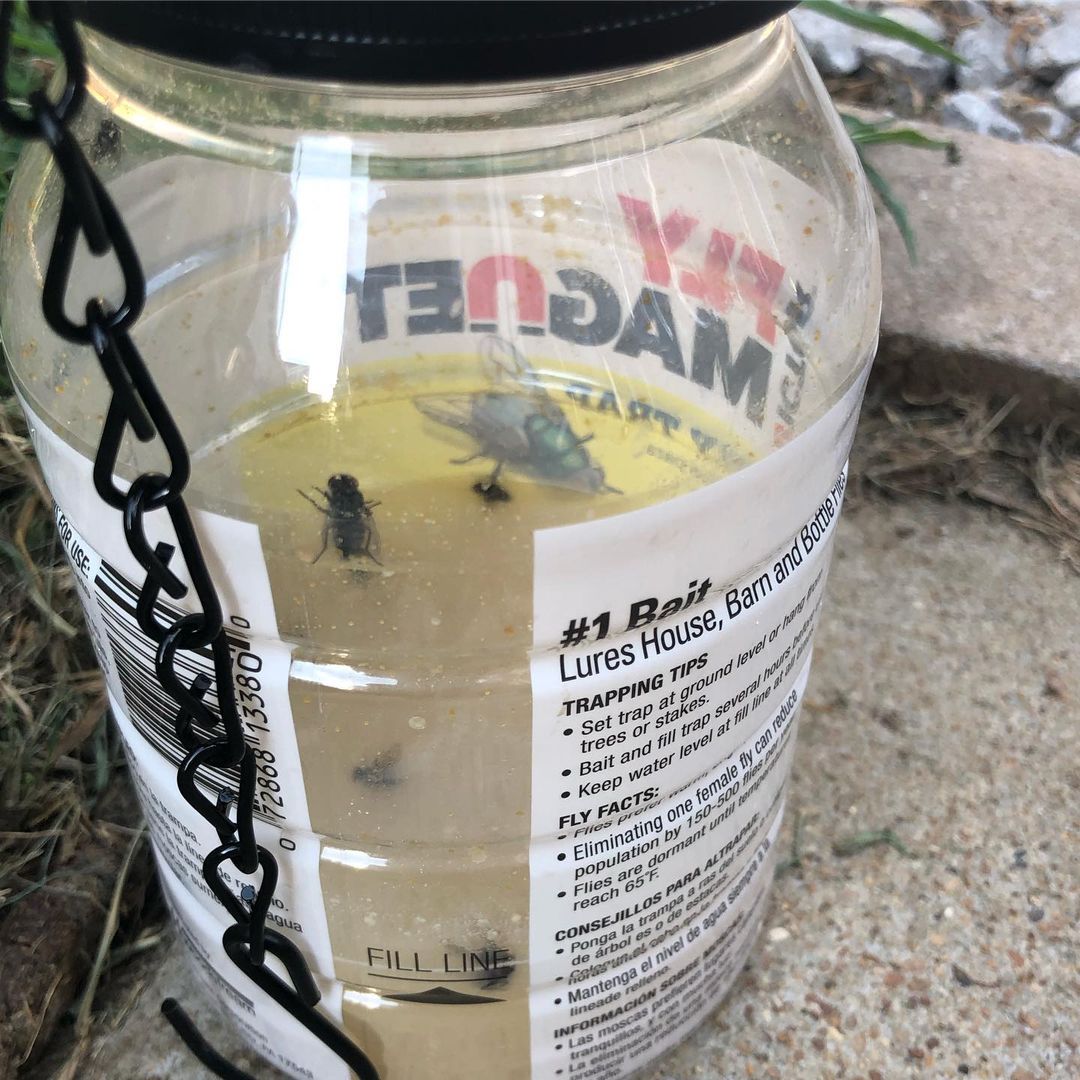
This liquid fly trap is based on a smelly non-poisonous chemical solution that effectively attracts flies. They get under the white cap on the top of the bottle and rarely return.
To take the most out of the item, you should hang it on a pole or under the roof of your patio. The effect is almost the same as if you hand an electrical trap. Flies will love the smell!
| Pros: | Cons: |
|
|
3. Fly Insecticide – Martin’s Permethrin 10%
[amazon box=”B00061MSS0″ template=”vertical” tracking_id=”how-to-get-rid-of-flies-outside-20″ button_text=”Check price on Amazon”]
A powerful insecticide, permethrin, that can remove insects both indoors and outdoors. You should dilute it as mentioned in the instruction and use it for the initial cleanup of infested areas. It will not only damage the breeding site but also repel flies in the nearby future by making the location unsuitable for dwelling.
Moreover, the concentrate is enough for covering large areas as 1.33 ounces is adequate for a gallon of an efficient water-based solution.
| Pros: | Cons: |
|
|
4. Flying Insect Killer Aerosol – PT Alpine Pressurized Fly Bait
[amazon box=”B019J1WL0W” template=”vertical” tracking_id=”how-to-get-rid-of-flies-outside-20″ button_text=”Check price on Amazon” button_detail=”https://shareasale.com/r.cfm?b=410159&u=2583381&m=43235&urllink=www%2Edomyown%2Ecom%2Fpt%2Dalpine%2Dpressurized%2Dfly%2Dbait%2Dp%2D12299%2Ehtml&afftrack=how%20to%20get%20rid%20of%20flies%20outside” button_detail_text=”Check price on DoMyOwn”]
Specifications:
- Item Form: Spray
- Item Volume: 16 Fl. Oz.
- Item Weight: 1 pounds
- Item Dimensions LxWxH: 3 x 3 x 9 inches
- Target Species: Fly
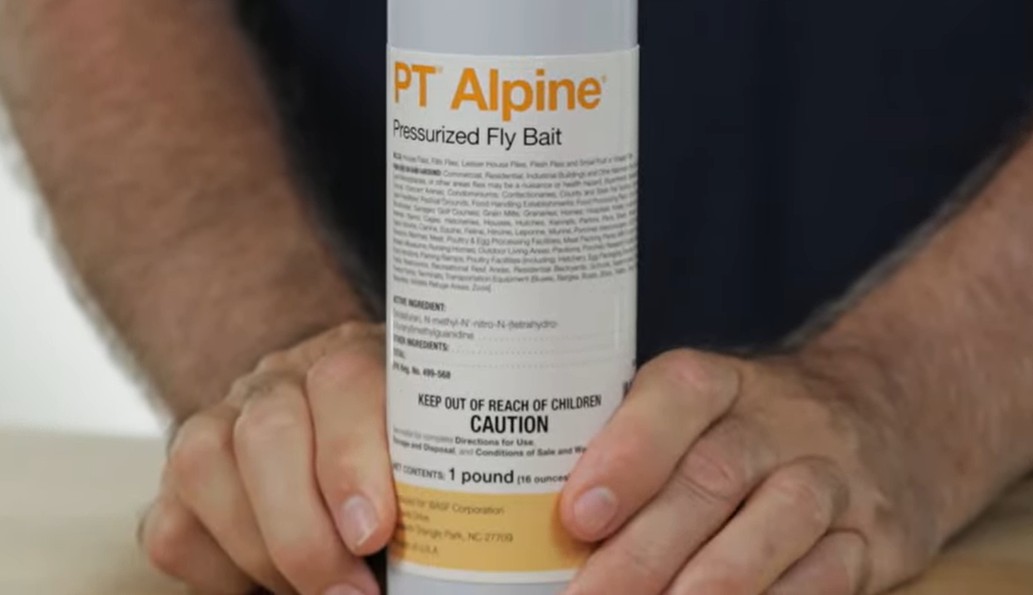
This spray provides a 30-day deadly effect against all fly species. You can easily spray it on surfaces of the infested site and it will quickly attract and poison them with dinotefuran. The solution is resistant to UV rays so that you can spray it on open structures. Besides, flies cannot detect it so they won’t learn to avoid the treated site.
It’s a simple, ready-to-use product that you can successfully apply on outdoor structures to get rid of flies forever. I recommend you to treat surfaces that aren’t exposed to rain to avoid leaching of the remedy.
| Pros: | Cons: |
|
|
5. Racket-Style Handheld Zapper – Twin-Pack of Bug Zappers by ZAP IT!
[amazon box=”B07GN4JZL8″ template=”vertical” tracking_id=”how-to-get-rid-of-flies-outside-20″ button_text=”Check price on Amazon”]
Specifications:
- Is Electric: Yes
- Number of Pieces: 2
- Item Weight: 1.7 pounds
- Item Dimensions LxWxH: 17.17 x 13.5 x 1.97 inches
- Target Species: Fly, Mosquito, Spider, Wasp
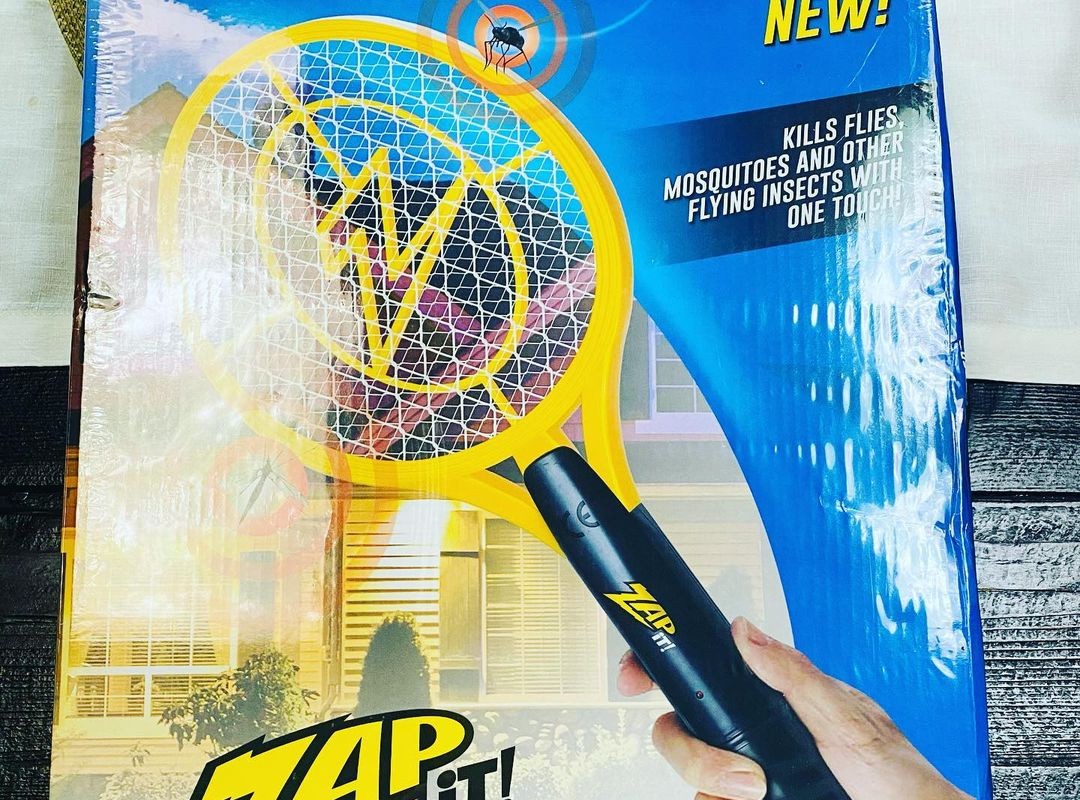
This handheld zapper offers a universal setup. It has a big round electrified mesh protected with a safety-layer with holes that are large enough for flies to get through and small enough to keep your fingers from burns. You have to switch the device on and just manage to touch the insect to kill it with a discharge.
It’s an excellent option for outside cooking sites, picnics, camping, and other occasions where you can’t use outlet-powered items and smelly chemical solutions. In addition, it has a built-in light bait that attracts both flies and mosquitoes to let you kill them faster.
| Pros: | Cons: |
|
|
Conclusion
Now you know how to get rid of flies in the yard and are ready to stop the infestation. Following my guide, you should be consistent in defining the cause of the infestation properly and select the right remedies. Unfortunately, the process may take longer than you expect, especially when there are several reasons for the infestation.
Have you faced any problems with flies before? How did you manage to solve them? Please, share your cases in the comments section below and feel free to ask me any questions related to the topic unless they’re already answered in the buyer’s guide and FAQ sections of the article.
References:
- Common Green Bottle Fly (University of Florida):
http://entnemdept.ufl.edu/creatures/livestock/flies/lucilia_sericata.htm - Resistance of House Fly, Musca domestica L. (Diptera: Muscidae), to Five Insecticides in Zhejiang Province, China: The Situation in 2017 (US National Library of Medicine
National Institutes of Health):
https://www.ncbi.nlm.nih.gov/pmc/articles/PMC6612408/

